Thundercloud Plum Tree Prunus cerasifera Thundercloud
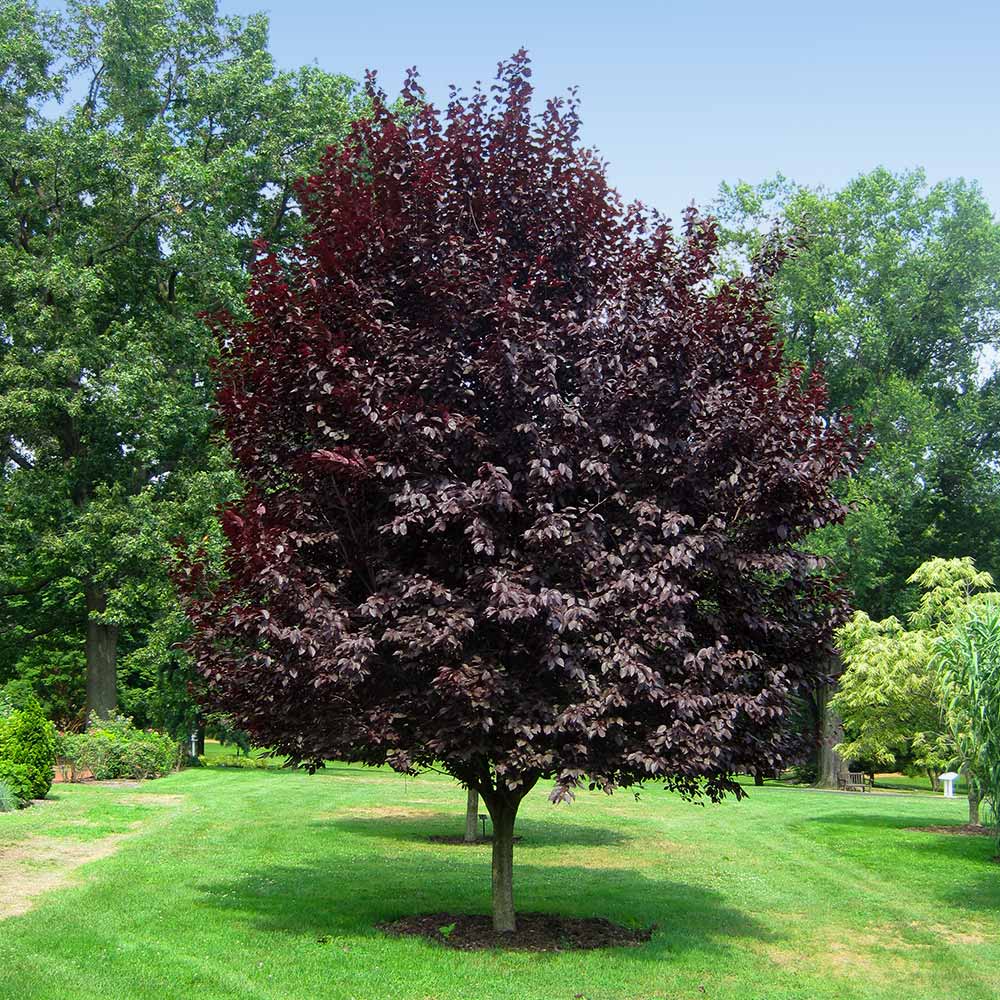
This mature Thundercloud Plum has dark leaves that are a dramatic statement.
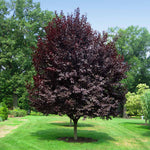
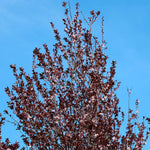
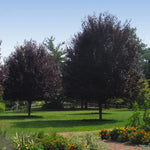
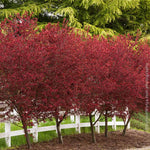
* Images shown are of mature plants
Thundercloud Plum Tree Prunus cerasifera Thundercloud
Product Description
A Rainbow of Colors from Spring through Fall
You can break up the monochromatic look of your green landscape by planting a single Thundercloud Plum tree (Prunus cerasifera 'Thundercloud'). It throws a riot of color into the entire growing season, beginning in early spring and ending in autumn. After its colorful transition from pinkish-white flowers to red leaves to purple foliage, it flashes another shade of red with its tiny fruits while retaining its rich purple foliage through fall!
A Flurry of Flowers and Vibrant Foliage
Thundercloud Plum doesn't bear typical plum fruits; in fact, it's classified as an "ornamental" plum tree. It's also known as purple-leaf plum because of its foliage color and cherry plum because of the red cherry-sized fruits that appear on many trees. No matter what you call it, Thundercloud Plum will be a vibrant addition to your landscape design because of its:
• Showy, fragrant flowers. Plum trees bloom in early spring before their leaves appear. Thundercloud's flowers may remind you of the peaceful calm before the storm of emerging leaves begins to open. Delicate pinkish-white blooms profusely cover these trees to usher in springtime with an eye-popping display.
• Transitioning leaf color. As the new leaves emerge in springtime, they are a vivid shade of ruby-red. As they mature, the color deepens to a rich purple.
• Striking appearance as a specimen plant. In the landscape-design world, a "specimen plant" is one that you plant as a focal point, which stands out among other landscape features. This type of plant draws the eye toward it '– it's a showpiece among other plants in the landscape. Thundercloud Plum is a true showpiece!
Richly Modest Purple Leaves Until Autumn
Purple has long been associated with royalty, and Thundercloud Plum tree's lavishly colored foliage is indeed regal-looking. This is a tree that will not overpower your landscape, particularly if you have a small yard. Its mature height, which reaches approximately 20 feet, and its equal width give it a perfectly balanced, rounded shape. Thundercloud Plum's perennial range extends across USDA Plant Hardiness Zones 5 through 8, where it is both cold- and heat-tolerant. As a deciduous tree, Thundercloud Plum will lose its leaves in autumn, but this exposes the bare branches for maximum viewing of the breathtaking spring flowers!
A Plum-Perfect Container Plant
Thundercloud Plum tree makes an elegant container plant. Use a large pot (a drainage hole is essential), and fill it with commercial potting mix that's blended specifically for container plants. If your yard is already maxed out with landscape plants, or if you have a shady yard, you can grow Thundercloud Plum in a pot on your sunny patio. You can also pair two trees in matching pots, one on each side of the sunny walkway at your home's entrance. And even though its mature landscape height tops out around 20 feet, it will not grow this tall in a pot. Don't forget to keep it watered well, particularly during hot summers.
Small Edible Fruit Perfect for Jam
Although Thundercloud Plum's fruits are edible, they will not taste like the large plums you're accustomed to eating '– those are produced on a different kind of plum tree. If you enjoy home-canning projects, you can use these fruits to make jam, jelly, or preserves. Just remember that the fruit quality is not as good as what you'd harvest from an edible plum tree, because Thundercloud Plum trees are prized for their flowers and foliage instead of their fruit quality. And they don't typically produce tons of fruit as edible plum trees do. Some years you may see very little fruit, and other years you may have a bumper crop.
A Living Bird Feeder
If you want to try your hand at making Thundercloud Plum preserves, fair warning '– you'll have to compete with the birds! Our feathered friends relish these fruits and gobble them eagerly from the trees, which makes Thundercloud Plum a natural bird feeder in your wildlife-friendly garden. Plant it near your favorite garden chair, and bring your binoculars! You may see a variety of songbirds that do not visit seed feeders because they prefer eating fruit.
Great as a Shade Tree
Thundercloud Plum can cast shade in a section of your garden where you want to grow shade-loving plants. This tree needs full sun to optimize its purple foliage color, but if you place it where its shadow protects shade-loving perennials during hot summer afternoons, you've created an instant shade garden for other plants by planting a sun-loving tree! You can also plant Thundercloud Plum to shade your favorite sitting area, but you may need to locate it so that you're sitting at the tail of its long shadow instead of directly beneath it. Any small fruits that the birds don't eat will end up on the ground, and you don't want them to fall onto your patio or favorite chair!
Plant it for the Pollinators
Thundercloud Plum flowers very early; during a time when most flowering plants haven't yet popped into bloom. The timing of this tree's blossoms provides an early-season nectar and pollen source that is vital for pollinators. Bees and other insects that have been holed up during the winter begin to emerge in springtime before summer's flowers haven't begun to open. Planting spring-blooming trees, such as Thundercloud Plum, not only delights your senses but provides a food source for these pollinators.
The Importance of a Sunny Location for This Tree
The sun actually intensifies the purple color of Thundercloud Plum's foliage. When these trees are planted in shady locations, their leaves will become green. And you'll be so disappointed to plant a purple-leaf plum tree that ends up being a green-leaf plum tree! The easy fix? Bring on the sun!
Other Growing Considerations for a Healthy Tree
• Soil. Thundercloud Plum trees are adaptable to nearly every kind of soil '– sand, clay, and loam '– as long as it doesn't hold standing water.
• Water. Deep, thorough watering after transplanting and during its first few growing seasons helps Thundercloud Plum tree develop a strong and healthy root system. After they're established, the tree won't need as much water, but keep a heads-up approach during periods of drought. If natural rainfall doesn't supply 1 inch of water each week, give your Thundercloud Plum tree a deep soaking.
• Mulch. Mulch meets numerous needs for Thundercloud Plum. A thick, 3- to 4-inch layer of mulch spread underneath the tree, to the entire width of its canopy, helps keep the soil moist and reduces your need for watering. The mulch also helps to suppress weeds, which compete with the tree for water and nutrients, plus you won't have to get out your string trimmer or mower and keep the grass and weeds tidy. This is important to the health of Thundercloud Plum in another way '– these trees don't respond well if they are nicked or damaged. Any wound opens up the bark to potential invasion by disease organisms. Exercise care when working around Thundercloud Plum so the bark stays intact.
• Fertilizer. This tree doesn't have a high need for fertilizer; typically, average garden soil contains the nutrients it needs. But without playing a blind guessing game of how much fertilizer to use, the results of a soil test will tell the tale. Call on your local Cooperative Extension Service to perform a soil test to determine soil fertility and your tree's specific needs. If it needs fertilizer, the best time to apply it is early spring before the new growth emerges.
• Pruning. This is not a pruning-intensive tree. It grows into a naturally rounded, slightly vase-shaped form without needing you to prune it to maintain this shape. It's classified as a "break-resistant" tree, which means it has strong branches. But occasionally, you may need to remove broken branches, or give the tree a little trim. The best time to prune it is in winter, while the leaves are still off the tree.
How to Use Purple in Your Landscape Design
By choosing a palette of colors for your landscape, you're like an artist selecting colors for a painting. You want your landscape design to reflect your preferences and to communicate this with those who see it, but you also want to create a masterpiece that uses color effectively. Color sets the mood for an entire landscape or for different zones within the same landscape. Cool primary colors, such as blue and green, evoke calm feelings. Warm primary colors, such as red and yellow, are energizing. Purple is a secondary color, which means it's created from two primary colors '– blue and red. Since blue is a cool color and red is a warm color, purple can actually be perceived as a cool or warm color, depending on the colors around it! For example, if you plant purple-leaf Thundercloud Plum near evergreens that have blue-green foliage, you've created a calm color grouping for a quiet sitting area. But if you plant Thundercloud Plum near evergreens with yellow-green foliage, you've created an entirely different mood that energizes your landscape ?… and you!
Shipping Details
Estimated Shipping Time: Most orders ship within 1-2 days. As noted on the website, some items are seasonal, and may only ship in spring or fall. Once your order is shipped, you'll receive an email with a tracking number.
| Order Total | Shipping Charges |
|---|---|
| Less than $100 | $24.95 |
| $100.00-$128.99 | $29.95 |
| $129 + | FREE SHIPPING! |
Product Details
Growing Zones: 5-8 outdoors
 5-8 outdoors
(hardy down to -10℉)
5-8 outdoors
(hardy down to -10℉)
- Mature Height: 15-25 ft.
- Mature Width: 15-25 ft.
- Sunlight: Full to Partial Sun
- Spacing: 25 ft.
- Growth Rate: up to 2 ft.
- Does Not Ship To: AR, AZ, CA, ID, LA, WA
Customer Reviews & Photos





